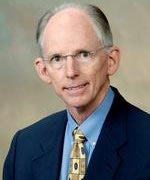Money key factor in driving students from primary care
Primary care physicians are at the heart of health care in the United States and are often the first to diagnose patients and ensure those patients receive the care they need.
But researchers from East Carolina University, N.C. State University and the Albert Einstein College of Medicine of Yeshiva University in New York have found that many students are choosing to pass up a career in primary care because those physicians make substantially less money than specialists, such as dermatologists or radiologists.

Dr. Dale Newton
“We found that students who placed a premium on high income and students who anticipated having a lot of student debt were significantly more likely to pursue a high-paying medical specialty rather than become primary care physicians,” said Dr. Lori Foster Thompson, a professor of psychology at N.C. State and co-author of a paper describing the research. “This held true even for students who entered medical school with the goal of becoming primary care physicians – they often switched to high-paying specialties before graduating.”
The study, published online this week in Medical Education, surveyed more than 2,500 medical students attending New York Medical College and the Brody School of Medicine at ECU between 1993 and 2012. Students were surveyed at the beginning of their first year of medical school and just before graduation four years later. The survey asked the students what sort of medical career they planned to pursue, to estimate their final student loans and to rate the value they place on income.
The researchers then looked at those students planning to pursue a career in primary care, as well as those students planning to pursue any of the 12 specialties with a median income of more than $300,000 per year, based on 2010 salary data. By comparison, primary care physicians had a median income of just under $200,000 per year. Primary care consists of internal medicine, family medicine and pediatrics.
The study found that anticipated debt was a significant factor in the students’ career decisions. Graduating students who pursued high-paying specialties were facing average student loans of approximately $104,000, whereas those who chose primary care faced an average debt of less than $94,000. Students facing higher debt were also more likely to switch to high-paying specialties – including more than 30 percent of students who had expected to become primary care physicians when they entered medical school.
“The income gap between primary care and specialty physicians started growing in earnest in 1979, and now we’re seeing the consequences of that ongoing trend,” said Dr. Martha Grayson, senior associate dean of medical education at Einstein and the study’s lead author. (Grayson was at New York Medical College at the time of the study.)
First-year and graduating students who chose to pursue one of the high-paying specialties also rated income as being significantly more important than students who chose to pursue primary care. In addition, those graduating students who felt income was more important than they had as first-years were more likely to have switched to a high-paying specialty.
Dr. Dale Newton of ECU, a study co-author, said other factors that guide student decisions about what specialty to pursue include parental or peer pressure, lifestyle desires and the exposure to more specialties once students reach medical school, though this study didn’t look at those issues specifically.
“The other major factor in choosing a primary care career is a service commitment — wanting to help others,” added Newton, a professor of pediatrics at ECU. “Measuring such a commitment in a research setting is very difficult, however.”
Based on an Association of American Medical Colleges survey of residents and fellows taken in 2010, 86 percent of medical students graduated with some education debt in 2010. The average debt was $158,000. Thirty percent of graduates had debt exceeding $200,000.
“While the amount of debt medical students take on is well-known, there hasn’t been much research to assess how students respond to this pressure,” said Grayson.
The study suggests exploring measures to encourage primary care careers such as incentive pay, debt forgiveness, additional scholarships and higher reimbursement for primary care services in order to meet the growing need.
Such measures would be good for ECU, which emphasizes primary care and has the lowest tuition of any medical school in the country, Newton said.
“The good news is that our low medical school cost for tuition and fees means that our students graduate with lower debt loads in general,” he said. “That means that more of them can ‘afford’ to choose a lower-paying primary care career. If the current efforts at health care reform continue, the incomes of primary care physicians should improve over the next few years. Primary care has to play a major role in the new health care paradigm.”
The study findings come as the AAMC projects a shortage of 63,000 physicians by 2015, the vast majority of those in primary care.
The paper is titled “Payback Time: The Association of Debt and Income with Medical Student Career Choice.” It is online at http://onlinelibrary.wiley.com/doi/10.1111/j.1365-2923.2012.04340.x/abstract.